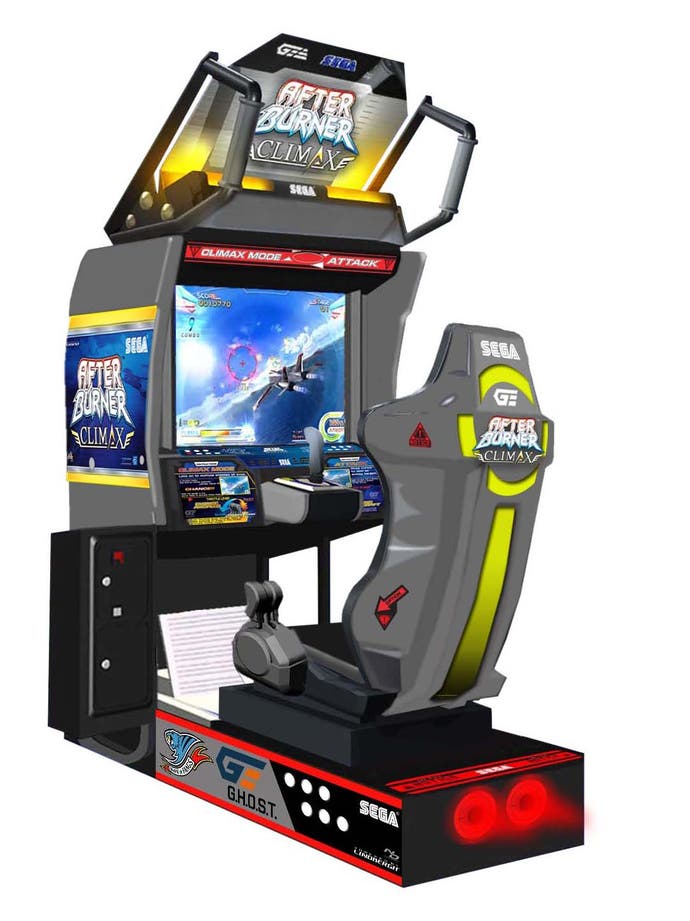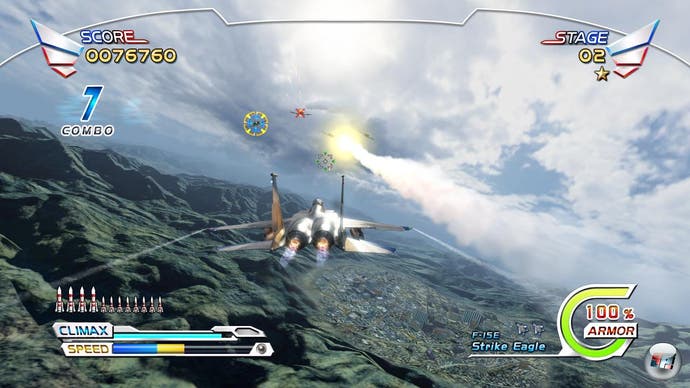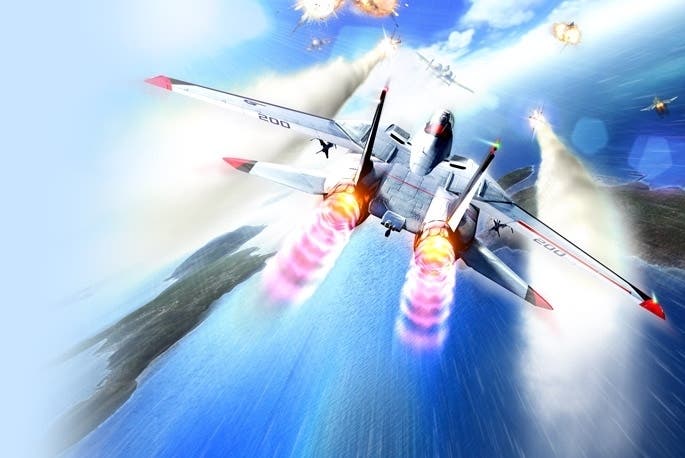After Burner Climax retrospective
Blue skies.
I remember it well: it was the spring of 1988 and the fair was in town. The arcades were singing with sounds from JAMMA's finest era - Double Dragon's coin drop noise punctuated the chatter of Operation Wolf's plastic Uzi. Magical Sound Shower blares from a stand-up OutRun, sitting right next to a dog-eared Hang-On cabinet that no-one ever plays. But there was something new - a brand-new sit-down with a jet fighter control stick and a throttle lever. It was 50p a credit, but it was glorious. It was After Burner.
It was actually After Burner 2, but no-one really cared to notice. The giveaway was in the numerals encoded in a vectorball logo, which span around as part of the attract sequence. This tour-de-force in sprite scaling was a subtle testament to the power of Sega's System-X board, but the game didn't really need abstract demoscene-esque trickery to make jaws drop. The sight of that white F-14 hurtling across sun-blazed tropical seas, dark cityscapes and desert canyons was enough.

It may have cost two goes on Double Dragon, but After Burner was worth every penny - even the death explosions were value for money. I remember being agape at my flaming plane diving into the ground, astonished by the sheer intensity of it all. Some called it shallow - it was an on-rails shooter, with less control than Space Harrier, but its depth wasn't from its game mechanics. It was from the visceral rush of Sega's System-X board with the throttle at max, chucking around AM2's glorious vistas with a smoothness and fidelity we'd never see at home.
18 years later, Sega released After Burner Climax into the arcades. It was a swansong of sorts - a fabulous tribute to 80s excess along much the same lines as OutRun 2, the imagery turned into modern polygons with a fancy new gameplay mechanic on top. I was lucky enough to play the cab at the Trocadero in London. Again, I was dazzled by the visual finesse. It was heart-stoppingly beautiful, showing that AM2's team knew exactly what it was doing while treating its hallowed IP with impeccable respect - right down to including those vectorballs in the original's intro, re-imagined now as HD spheres.
In 2010, Sega produced Xbox 360 and PlayStation 3 versions. As a console game, After Burner Climax appears hilariously lightweight. Common criticisms were of its play length - a ten-minute run is all it takes to get to the end - but this misses the point: it's a glorious ten minutes. This also misses the genius twist in Climax's home versions: the Ex options. Unlocked by simply playing through the game as best you can, these successively stack up to transform After Burner Climax into a mad thrill-toy.
You can make your flight more difficult if you want, but the Ex options have more power in turning arcade-hard challenge into home leisure. You can ramp up your plane's abilities and soften the enemies. You can (eventually) set the signature Climax Mode special attack to do everything automatically, removing any dangers from enemy planes and missiles. You can turn off the smoke and explosions to clear the view, so it's just you and the landscape. Sure, you can chase scores and unlock all the awards and trophies, but nearly every game does that. After Burner Climax invites you to try something else: to experience its wild ride for the thrill and the beauty of it. To go away, Daytona-style, by flying into AM2's most glorious landscapes.
After Burner Climax has a unique merit; it's a spectacular celebration of Sega's arcade aesthetic. The skies are so rich and saturated that the colour is intoxicating. Clouds add to the sense of pace and the first stage's shimmering sea is a perfect update of the original. The landscapes rush by so fast that you don't really notice how low-poly they can be, and it doesn't matter - they still look gorgeous. Breakneck dashes along canyons and through arctic underground bases are thrilling, while volcanic islands, aurora borealis and hazy deserts are worth replaying just to soak up their visual splendour.

It's a grand claim, but I think that in creating After Burner Climax, AM2 pulled off the finest and most utterly correct upgrade of low-res bitmaps to hi-res textured polygons ever undertaken, creating one of the most visually beautiful games ever made. We often find ourselves impressed by modern graphics - by the realism or the style. We have awards for "best" visuals, but we don't always award the sublime. After Burner Climax is an encounter with that visual sense of the sublime and I'm pretty sure a flight through stages like Vertical Hot Air or Clouds of Twilight would convince anyone that they're witnessing true beauty.
Transcendent sensory experiences aside, After Burner Climax is still a fun game to shoot through. That's thanks mostly to the addition of the Climax Mode special, which layers extra strategy on top of the original's paint-and-fire mechanic. It's quite the challenge to rigorously complete without cheating and is bags of fun to try and master.
It's also a great stopgap title, sitting alongside the likes of Bangai-O HD as modest games from legendary developers that are always on-hand when there's nothing compelling to put in the drive. Its arcade immediacy never slows you down with modern ills like movie titles, introductory exposition, character development or mood-setting and the entire tutorial, as part of the attract sequence, takes less than a minute to get through.
It's a tight little bastard of a game with beautiful looks and, as such, proof of AM2's remarkable talent as a developer. I can only hope AM2 gets another stab at revisiting its past work, because After Burner Climax demonstrates precisely how it should be done.

